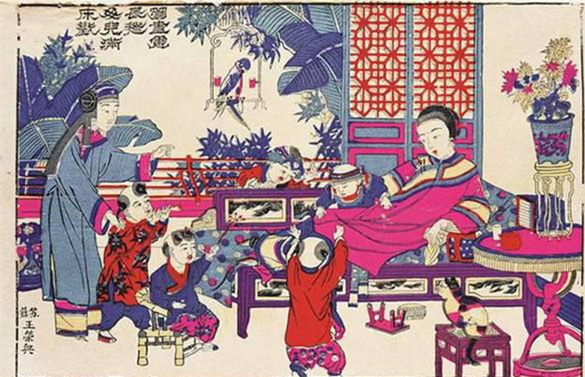
. > WHAT'S NEW > CONFERENCES
Seminar looks at global influence of Chinese woodblock printing
Author : WU NAN Source : Chinese Social Sciences Today 2018-01-30

Pictured above is a woodblock print depicting a happy family, produced in Taohuawu in Suzhou, Jiangsu Province. Taohuawu New Year prints were included in the first batch of national intangible cultural heritage list in May 2006.
The tradition of creating Chinese woodblock prints to celebrate the New Year historically served as an important cultural bridge between Asia and Europe, said experts at an international seminar for New Year prints coinciding with the first international exhibition of woodblock prints in Suzhou, Jiangsu Province on Jan. 8.
In the 17th century, Gusu woodblock prints from Suzhou were a significant part of trade and art exchange between China and Japan. Japan’s ukiyo-e integrated and learned from elements of Taohuawu New Year prints, which were profoundly influential on ukiyo-e’s aesthetic style. In the 18th century, Chinese culture made a mark in Europe. Gusu woodblock prints found a market in Europe, too. The British bookseller Hanshan Tang Books has the largest collection of Gusu woodblock prints that have been preserved in the world today.
Zhao Gang, dean of the School of Arts and Crafts at Suzhou Art and Design Technology Institute, said that these Taohuawu woodblock New Year pictures had a certain impact on local folk art creation and culture. Furthering international exchange on studies of Gusu woodblock paintings will help understand their artistic value and their influence on East-West folk art exchange and development, Zhao added.
Wang Xiaoming, who studies the Chinese prints and paintings collected at the British Museum, said that Gusu woodblock pictures spread to Europe through trade in the early Qing Dynasty. They became popular in Europe in the 17th century and continued to be fashionable until the end of the 18th century. During that period, Chinese folk woodblock prints were representative of a strong culture and exerted influence on the aesthetic tastes in Europe leading up to the 19th century. This indicates the dominance of Gusu woodblock paintings in cultural dissemination. In the history of East-West art exchange, the period between the Kangxi Emperor’s reign and early years of the Qianlong Emperor’s reign was a golden era for the spread of Gusu woodblock pictures overseas, Wang added.
Xu Wenqin, a research fellow from the Palace Museum in Taipei, said that Gusu woodblock paintings were first exported to Europe in big batches around the end of the 17th century. The majority of those exports were bird-and-flower paintings and figure paintings, while only a small portion were landscape paintings. The bird-and-flower woodblock paintings maintained the traditional features and were not Westernized, while the figure paintings were influenced by the French fashion, taking on the Baroque style. In the 1760s, as the painting styles and the Western demand changed, Gusu woodblock paintings began to fade from the European market, Xu said.
As a significant national cultural heritage bearing values from different historical periods, New Year paintings became an object of fascination for overseas Sinologists as early as the 20th century. The inheritance of folk arts and crafts was heavily impacted by urbanization at the end of the 20th century and in early 21st century. The old woodblock pictures, with their vivid folk culture, became collectors’ items for art aficionados. In recent years, with the implementation of projects to promote the development of traditional Chinese culture and the Plan on Revitalizing China’s Traditional Crafts, production skills of woodblock New Year pictures have witnessed rapid recovery and development.
Ye Shengtao made Chinese fairy tales from a wilderness
Ye Shengtao (1894–1988) created the first collection of fairy tales in the history of Chinese children’s literature...
-
How northern ethnicities integrated into Chinese nation
2023-09-18
-
Mogao caves
2023-09-12
-
Mogao Grottoes as ‘a place of pilgrimage’
2023-09-12
-
Time-honored architectural traditions in China
2023-08-29
-
Disentangling the civilizational evolution of China
2023-08-28
-
AI ethics in science fiction
2023-08-23













 2011-2013 by www.cssn.cn. All Rights Reserved
2011-2013 by www.cssn.cn. All Rights Reserved